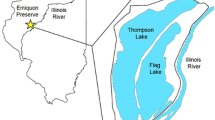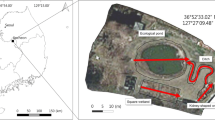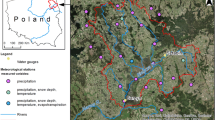Abstract
It has been hypothesized that wetland restoration policies have favored the restoration of the wettest classes of wetlands on the Des Moines Lobe of the prairie pothole region. To test this hypothesis we compared pre-drainage wetland distributions based on soils data and National Wetland Inventory (NWI) estimates of contemporary wetland distributions on the Des Moines Lobe. Based on the NWI data, the Des Moines Lobe today has only 3–4% of the wetland area that it had prior to the onset of drainage. On the basis of their soils, pre-drainage wetlands were predominantly temporarily flooded to saturated wetlands (84%), with only about 6% of the wetlands with water regimes classified as semi-permanently to permanently flooded. Depending on the interpretation of wetland modifiers on NWI maps, wetlands classified by the NWI as semi-permanent to permanently flooded make up more than 41% of the wetland area while wetlands with temporarily flooded to saturated water regimes account for 45–58% of the Lobe’s wetland area. The water regimes of contemporary wetlands when compared to their historic regimes suggest that many of today’s wetlands have different water regimes than they did prior to the onset of drainage. Because of the regional lowering of the groundwater table, many of today’s wetlands have drier water regimes, but some have wetter water regimes because they receive drainage tile inputs. Our results indicate that restoration has favored the wettest classes of wetlands and that temporarily to saturated wetland classes have not been restored in proportion to their relative abundance in the pre-drainage landscape.



Similar content being viewed by others
References
Bishop RA (1981) Iowa’s wetlands. Proc Iowa Acad Sci 88(1):11–16
Bishop RA, van der Valk AG (1982) Wetlands. In: Cooper TC (ed) Iowa’s natural heritage. Iowa Natural Heritage Foundation and Iowa Academy of Science, Des Moines, pp 208–229
Bishop RA, Joens J, Zohrer J (1998) Iowa’s wetlands, present and future with a focus on prairie potholes. J Iowa Acad Sci 105(3):89–93
Cowardin, LM, Carter V, Golet FC, LaRoe ET (1979) Classification of wetlands and deepwater habitats of the United States. U.S. Department of Interior, Fish and Wildlife Service, Office of Biological Services, Washington, DC. FWS/OBS-79/31
Dinsmore JJ (1994) A country so full of game: the story of wildlife in Iowa. University of Iowa Press, Iowa City
Galatowitsch SM, van der Valk AG (1994) Restoring prairie wetlands: an ecological approach. Iowa State University Press, Ames
Galatowitsch SM, van der Valk AG (1996) Characteristics of newly restored prairie potholes. Wetlands 16:75–83
Galatowitsch SM, van der Valk AG, Budelsky RA (1998) Decision-making for prairie wetland restorations. Gt Plains Res 8:137–155
Hewes L (1951) The northern wet prairie of the United States: nature, sources of information, and extent. Ann Assoc Am Geogr 41(4):307–323
Iowa Department of Natural Resources (2011) Major rivers of Iowa. http://www.igsb.uiowa.edu/nrgislibx. Accessed 25 Aug 2011
Iowa Department of Natural Resources, U.S. Fish and Wildlife Service, and St. Mary’s University (2011) Natural Wetlands Inventory Remap and Update. http://www.igsb.uiowa.edu/nrgislibx. Accessed 27 Feb 2011
Johnson WC, Millett BV, Gilmanov T, Voldseth RA, Gunterspergen GL, Naugle DE (2005) Vulnerability of northern prairie wetlands to climate change. Bioscience 55:863–872
Kantrud HA, Krapu GL, Swanson GA (1989) Prairie basin wetlands of the Dakotas: a community profile. Technical Report, U.S. Fish and Wildlife Service
Miller BA, Crumpton WG, van der Valk AG (2009) Spatial distribution of historical wetland classes on the Des Moines Lobe, Iowa. Wetlands 29(4):1146–1152
Prince H (1997) Wetlands of the American Midwest: a historical geography of changing attitudes. University of Chicago Press, Chicago
Soil Survey Staff, Natural Resources Conservation Service, United States Department of Agriculture (2009) Official soil series descriptions (OSD). http://soils.usda.gov/technical/classification/osd/. Accessed 11 May 2009
Stewart RE, Kantrud HA (1971) Classification of natural ponds and lakes in the glaciated prairie region. Research Publication 92. U.S. Fish and Wildlife Service
van der Valk AG (1989) Northern prairie wetlands. Iowa State University Press, Ames
van der Valk AG (2005) Prairie potholes of North America. In: Keddy PA, Fraser LH (eds) The world’s largest wetlands: their ecology and conservation. Cambridge University Press, Cambridge, pp 415–445
Acknowledgments
We thank two anonymous reviewers and editors for suggestions on previous drafts. Support was provided by Ducks Unlimited, the Iowa Department of Agriculture and Land Stewardship, the United States Department of Agriculture, and by the Graduate College, the Environmental Science Program, the Department of Ecology Evolution and Organismal Biology and the Department of Agronomy at Iowa State University.
Author information
Authors and Affiliations
Corresponding author
Rights and permissions
About this article
Cite this article
Miller, B.A., Crumpton, W.G. & van der Valk, A.G. Wetland hydrologic class change from prior to European settlement to present on the Des Moines Lobe, Iowa. Wetlands Ecol Manage 20, 1–8 (2012). https://doi.org/10.1007/s11273-011-9237-z
Received:
Accepted:
Published:
Issue Date:
DOI: https://doi.org/10.1007/s11273-011-9237-z




